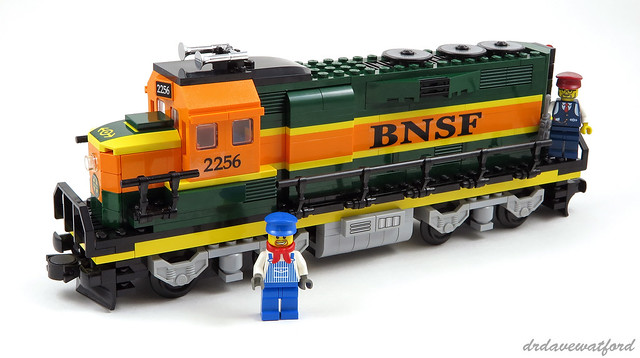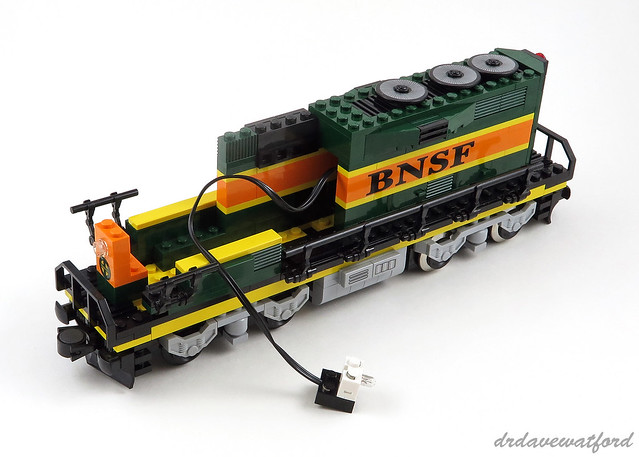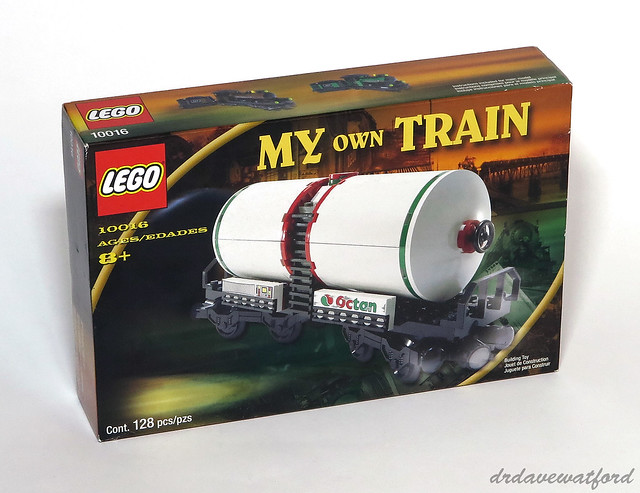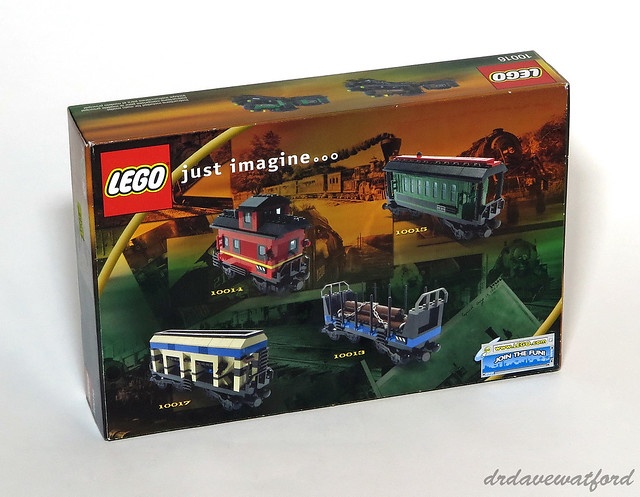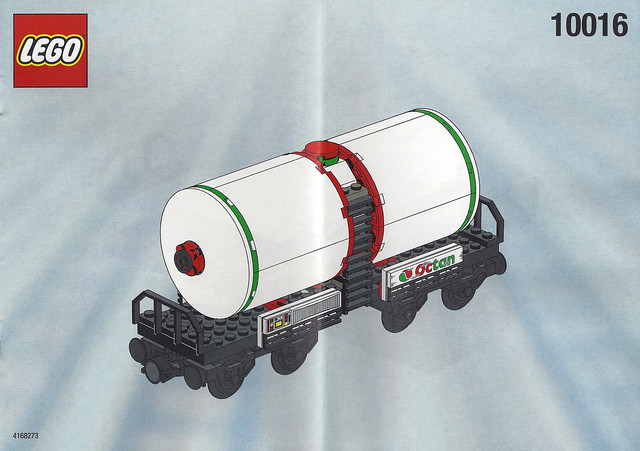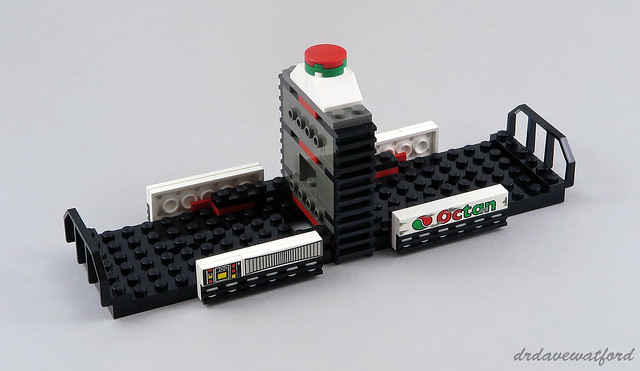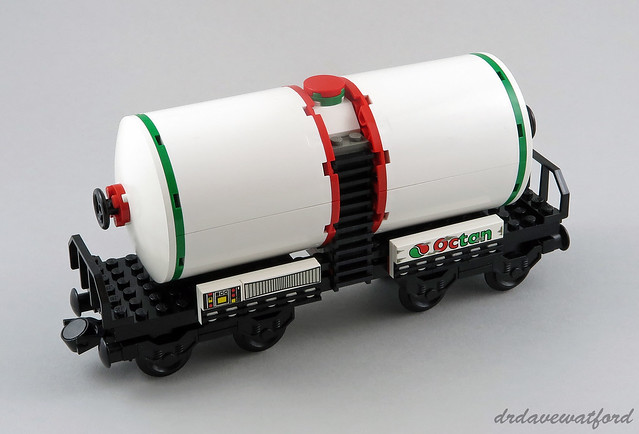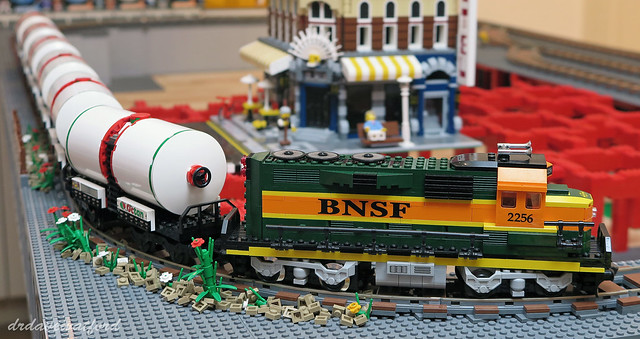Firstly, the set isn't motorised out of the box, so I needed to incorporate a motor in order to get it running. Thankfully, LEGO has helpfully devoted a few pages of the BNSF instruction booklet to the incorporation of a 9V motor into the locomotive, and since I'd recently laid 9V track on my layout this was exactly what I was looking to do. As an added bonus, I discovered that the instruction booklet also includes instructions (sample page below) for incorporating a working light at the front of the locomotive; LEGO even previously produced a service pack, 3748 Light Unit for Train, which includes all the required elements to do this. Unfortunately, at the time of writing there were only 5 Bricklink sellers anywhere in the world with copies of this service pack for sale; given that the lowest asking price was around £13 + shipping for a service pack containing just 4 elements I figured I could probably pick up the elements I needed individually on Bricklink for a lot less, and that was indeed the case.
Fitting a 9V motor to the BNSF locomotive turned out to be very straightforward, basically just a case of detaching the rear wheel assembly and clicking the 5mm pin at the top of the motor into the now-vacant hole in the underside of the train base. Anticipating the desire of purchasers to motorise the locomotive, LEGO included a pair of decorative sides in the BNSF set which attach to the sides of motor and give it the appearance of a standard brick-built wheel assembly. Installing a light at the front of the locomotive required a little more effort, however, necessitating the removal of the driver's cab and part of the bodywork. One end of a 36 stud-long wire is attached to the 9V motor, while the other end is threaded through the train base into the body of the locomotive (below) and attached to a 1 x 2 light brick which is installed immediately behind the orange 1 x 2 Technic brick at the front of the loco. The cab is then replaced and the body reconstructed.
With the locomotive now motorised and a light brick installed, the other question I had to address was what rolling stock it should haul. My assumption has always been that the BNSF locomotive is supposed to be paired with Set 10170 TTX Intermodal Double-Stack Car (below) on the basis of the similar set branding plus the fact that both sets were released at around the same time; further evidence is provided by the BNSF Railway Company itself which claims on its website to transport more intermodal units each year than any other railroad in the U.S.. The problem is that I only have a single copy of Set 10170, and a train consisting of the BNSF locomotive plus just a single intermodal double-stack car would look a bit rubbish I reckon. Of course there's always eBay or Bricklink, but with complete examples of Set 10170 regularly changing hands for anything up to £100 or more plus shipping I wasn't overjoyed at the prospect of paying out £300+ to lay my hands on a few more of them....
An alternative was therefore needed, and I immediate thought of Set 10016 Tanker Truck which was released in 2001. I've long had a soft spot for this set, perhaps as a result of its nostalgia-inducing Octan branding, and in fact you may already have seen one of these trucks in some of the more recent pictures of my layout such as this one. Anyway, as well as having a couple of 'official' copies of the set I also bought up the necessary elements from Bricklink and elsewhere a few years back to build a few more of them, so I certainly have enough to provide my BNSF locomotive with a worthwhile cargo to haul.
The front of the 10016 box (above) features an image of the assembled tanker truck and carries the My Own Train branding which graced more than forty 9V train-related sets between 2001 and 2004. A number of other 2001 My Own Train releases such as 10013 Open Freight Wagon and 10017 Hopper Wagon are showcased on the back of the box (below).
The set's 128 elements are supplied in three sealed bags, and the set box also contains a 16-page instruction booklet, the cover of which you can see below. Similar to the instruction booklet for the BNSF locomotive (reviewed by me here), there's no advertising or other filler included in the booklet at all - every page apart from the front cover is occupied by building instructions.
The set doesn't include any minifigures, and the build is quick and straightforward. The foundation of the tanker truck is a black 6 x 24 train base. Modified 1 x 6 plates with train wagon end are installed at either end of the train base, and brackets are placed along the sides to which a variety of printed tiles are attached (picture below). The 1 x 6 tile printed with 'distressed' Octan branding is rare, having only ever appeared in two sets including this one, while the white 1 x 4 tile with black stripes has featured in just 8 sets in total. The central structure which supports the tank is then constructed and a number of black 1 x 2 modified plates with ladder are attached on either side of it.
The tank is constructed in two identical halves which predominantly consist of white 4 x 4 x 6 quarter cylinders. These elements are quite rare in white, having only ever appeared in a total of 8 sets. The quarter cylinders are held together by red and green 4 x 4 round corner plates together with a central core of stacked 2 x 2 bricks. White 8 x 8 inverted dishes are attached at either end; similar to the cylinders these are surprisingly uncommon in this colour, having only ever appeared in five sets including this one. The two halves of the tank are then attached to the rest of the truck by way of a number of 1 x 4 modified bricks with 4 studs on one side which are incorporated into the central supporting structure. With the tank installed it's then just a case of constructing a couple of identical wheel assembies topped off with train bogie plates and clicking the wheel assemblies into the underside of the train base, at which point we're done.
I ended up with a total of six tanker trucks including the one I'd previously assembled. With my BNSF locomotive motorised and packing a working headlight, and some rolling stock now built, it was finally time to power up the upper loop of my work-in-progress city layout and do a test run (video clip embedded below, or here if the embedded clip won't play on your device). I did wonder whether the 9V motor might struggle when faced with the weight of the locomotive plus six tanker trucks, but as you can see from the video I needn't have worried - the motor shifts the trucks with surprisingly little difficulty, and indeed I suspect it could have managed to pull a few more as well.

I've really enjoyed playing with trains over the past few weeks, but it's turned out to be a really bad move financially. While I already owned the BNSF locomotive and tanker trucks featured in the last couple of Gimme LEGO posts, I got so engrossed in it all that I made the mistake of checking out the train-related LEGO offerings on eBay. This was of course very dangerous as I predictably ended up splashing out on a whole bunch of additional 9V trains and rolling stock. Beware - LEGO trains are addictive, and expensive....

